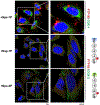Instructed Assembly of Peptides for Intracellular Enzyme Sequestration
- PMID: 30452246
- PMCID: PMC6470013
- DOI: 10.1021/jacs.8b10542
Instructed Assembly of Peptides for Intracellular Enzyme Sequestration
Abstract
Liquid-like droplets of biomacromolecules are emerging as a fundamental mechanism of cellular signaling, but designing synthetic mimics to form such membraneless organelles remains unexplored. Here we report the use of supramolecular assemblies of small peptides, as a mimic of biomacromolecular condensates, for intracellular sequestration of enzymes on endoplasmic reticulum (ER). Specifically, integrating a short peptide with naproxen (a nonsteroidal anti-inflammatory drug (NSAID) and a ligand of cyclooxygenase-2 (COX-2)) generates an enzymatic substrate that acts as a precursor for instructed assembly. Slowly dephosphorylating the precursors by phosphatases forms the corresponding hydrogelators in a cellular environment, which results in the supramolecular assemblies on ER. Consisting of the precursor and the hydrogelator molecules, the assemblies enable the sequestration of COX-2 and protein-tyrosine phosphatase 1B (PTP1B) on ER. Further structure-activity investigation reveals that the colocalization of COX-2 and PTP1B relies on the NSAID motif, the phosphotyrosine, and the enzymatic dephosphorylation of the precursor. This work, for the first time, illustrates the use of supramolecular processes for associating enzymes in cells and may provide insights for understanding intracellular liquid condensates and a new strategy for modulating protein-protein interactions.
Figures





Similar articles
-
D-amino acids boost the selectivity and confer supramolecular hydrogels of a nonsteroidal anti-inflammatory drug (NSAID).J Am Chem Soc. 2013 Jan 16;135(2):542-5. doi: 10.1021/ja310019x. Epub 2012 Nov 14. J Am Chem Soc. 2013. PMID: 23136972 Free PMC article.
-
Fluorophore-labeled cyclooxygenase-2 inhibitors for the imaging of cyclooxygenase-2 overexpression in cancer: synthesis and biological studies.ChemMedChem. 2014 Jan;9(1):109-16, 240. doi: 10.1002/cmdc.201300355. Epub 2013 Oct 31. ChemMedChem. 2014. PMID: 24376205
-
Enzymatic Assemblies Disrupt the Membrane and Target Endoplasmic Reticulum for Selective Cancer Cell Death.J Am Chem Soc. 2018 Aug 1;140(30):9566-9573. doi: 10.1021/jacs.8b04641. Epub 2018 Jul 24. J Am Chem Soc. 2018. PMID: 29995402 Free PMC article.
-
Computer aided drug design approaches to develop cyclooxygenase based novel anti-inflammatory and anti-cancer drugs.Curr Pharm Des. 2007;13(34):3505-17. doi: 10.2174/138161207782794275. Curr Pharm Des. 2007. PMID: 18220787 Review.
-
In control at the ER: PTP1B and the down-regulation of RTKs by dephosphorylation and endocytosis.Trends Cell Biol. 2010 Nov;20(11):672-9. doi: 10.1016/j.tcb.2010.08.013. Epub 2010 Sep 23. Trends Cell Biol. 2010. PMID: 20864346 Review.
Cited by
-
Cascaded amplification of intracellular oxidative stress and reversion of multidrug resistance by nitric oxide prodrug based-supramolecular hydrogel for synergistic cancer chemotherapy.Bioact Mater. 2021 Mar 13;6(10):3300-3313. doi: 10.1016/j.bioactmat.2021.03.005. eCollection 2021 Oct. Bioact Mater. 2021. PMID: 33778206 Free PMC article.
-
Intercellular Instructed-Assembly Mimics Protein Dynamics To Induce Cell Spheroids.J Am Chem Soc. 2019 May 8;141(18):7271-7274. doi: 10.1021/jacs.9b03346. Epub 2019 Apr 30. J Am Chem Soc. 2019. PMID: 31033285 Free PMC article.
-
Recent advances in synthetic and medicinal chemistry of phosphotyrosine and phosphonate-based phosphotyrosine analogues.RSC Med Chem. 2020 Oct 15;12(1):8-23. doi: 10.1039/d0md00272k. RSC Med Chem. 2020. PMID: 34041480 Free PMC article. Review.
-
Peptide hydrogel-drug conjugates for tailored disease treatment.Mater Today Bio. 2024 Dec 25;31:101423. doi: 10.1016/j.mtbio.2024.101423. eCollection 2025 Apr. Mater Today Bio. 2024. PMID: 39944533 Free PMC article. Review.
-
Intracellular artificial supramolecules based on de novo designed Y15 peptides.Nat Commun. 2021 Jun 7;12(1):3412. doi: 10.1038/s41467-021-23794-6. Nat Commun. 2021. PMID: 34099696 Free PMC article.
References
Publication types
MeSH terms
Substances
Grants and funding
LinkOut - more resources
Full Text Sources
Research Materials
Miscellaneous

